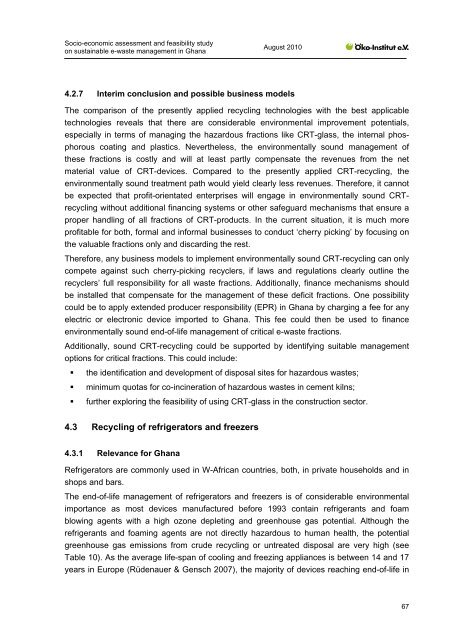Socio-economic assessment and feasibility study on - Öko-Institut eV
Socio-economic assessment and feasibility study on - Öko-Institut eV
Socio-economic assessment and feasibility study on - Öko-Institut eV
You also want an ePaper? Increase the reach of your titles
YUMPU automatically turns print PDFs into web optimized ePapers that Google loves.
<str<strong>on</strong>g>Socio</str<strong>on</strong>g>-<str<strong>on</strong>g>ec<strong>on</strong>omic</str<strong>on</strong>g> <str<strong>on</strong>g>assessment</str<strong>on</strong>g> <str<strong>on</strong>g>and</str<strong>on</strong>g> <str<strong>on</strong>g>feasibility</str<strong>on</strong>g> <str<strong>on</strong>g>study</str<strong>on</strong>g><br />
<strong>on</strong> sustainable e-waste management in Ghana<br />
August 2010<br />
4.2.7 Interim c<strong>on</strong>clusi<strong>on</strong> <str<strong>on</strong>g>and</str<strong>on</strong>g> possible business models<br />
The comparis<strong>on</strong> of the presently applied recycling technologies with the best applicable<br />
technologies reveals that there are c<strong>on</strong>siderable envir<strong>on</strong>mental improvement potentials,<br />
especially in terms of managing the hazardous fracti<strong>on</strong>s like CRT-glass, the internal phosphorous<br />
coating <str<strong>on</strong>g>and</str<strong>on</strong>g> plastics. Nevertheless, the envir<strong>on</strong>mentally sound management of<br />
these fracti<strong>on</strong>s is costly <str<strong>on</strong>g>and</str<strong>on</strong>g> will at least partly compensate the revenues from the net<br />
material value of CRT-devices. Compared to the presently applied CRT-recycling, the<br />
envir<strong>on</strong>mentally sound treatment path would yield clearly less revenues. Therefore, it cannot<br />
be expected that profit-orientated enterprises will engage in envir<strong>on</strong>mentally sound CRTrecycling<br />
without additi<strong>on</strong>al financing systems or other safeguard mechanisms that ensure a<br />
proper h<str<strong>on</strong>g>and</str<strong>on</strong>g>ling of all fracti<strong>on</strong>s of CRT-products. In the current situati<strong>on</strong>, it is much more<br />
profitable for both, formal <str<strong>on</strong>g>and</str<strong>on</strong>g> informal businesses to c<strong>on</strong>duct ‘cherry picking’ by focusing <strong>on</strong><br />
the valuable fracti<strong>on</strong>s <strong>on</strong>ly <str<strong>on</strong>g>and</str<strong>on</strong>g> discarding the rest.<br />
Therefore, any business models to implement envir<strong>on</strong>mentally sound CRT-recycling can <strong>on</strong>ly<br />
compete against such cherry-picking recyclers, if laws <str<strong>on</strong>g>and</str<strong>on</strong>g> regulati<strong>on</strong>s clearly outline the<br />
recyclers’ full resp<strong>on</strong>sibility for all waste fracti<strong>on</strong>s. Additi<strong>on</strong>ally, finance mechanisms should<br />
be installed that compensate for the management of these deficit fracti<strong>on</strong>s. One possibility<br />
could be to apply extended producer resp<strong>on</strong>sibility (EPR) in Ghana by charging a fee for any<br />
electric or electr<strong>on</strong>ic device imported to Ghana. This fee could then be used to finance<br />
envir<strong>on</strong>mentally sound end-of-life management of critical e-waste fracti<strong>on</strong>s.<br />
Additi<strong>on</strong>ally, sound CRT-recycling could be supported by identifying suitable management<br />
opti<strong>on</strong>s for critical fracti<strong>on</strong>s. This could include:<br />
� the identificati<strong>on</strong> <str<strong>on</strong>g>and</str<strong>on</strong>g> development of disposal sites for hazardous wastes;<br />
� minimum quotas for co-incinerati<strong>on</strong> of hazardous wastes in cement kilns;<br />
� further exploring the <str<strong>on</strong>g>feasibility</str<strong>on</strong>g> of using CRT-glass in the c<strong>on</strong>structi<strong>on</strong> sector.<br />
4.3 Recycling of refrigerators <str<strong>on</strong>g>and</str<strong>on</strong>g> freezers<br />
4.3.1 Relevance for Ghana<br />
Refrigerators are comm<strong>on</strong>ly used in W-African countries, both, in private households <str<strong>on</strong>g>and</str<strong>on</strong>g> in<br />
shops <str<strong>on</strong>g>and</str<strong>on</strong>g> bars.<br />
The end-of-life management of refrigerators <str<strong>on</strong>g>and</str<strong>on</strong>g> freezers is of c<strong>on</strong>siderable envir<strong>on</strong>mental<br />
importance as most devices manufactured before 1993 c<strong>on</strong>tain refrigerants <str<strong>on</strong>g>and</str<strong>on</strong>g> foam<br />
blowing agents with a high oz<strong>on</strong>e depleting <str<strong>on</strong>g>and</str<strong>on</strong>g> greenhouse gas potential. Although the<br />
refrigerants <str<strong>on</strong>g>and</str<strong>on</strong>g> foaming agents are not directly hazardous to human health, the potential<br />
greenhouse gas emissi<strong>on</strong>s from crude recycling or untreated disposal are very high (see<br />
Table 10). As the average life-span of cooling <str<strong>on</strong>g>and</str<strong>on</strong>g> freezing appliances is between 14 <str<strong>on</strong>g>and</str<strong>on</strong>g> 17<br />
years in Europe (Rüdenauer & Gensch 2007), the majority of devices reaching end-of-life in<br />
67

















